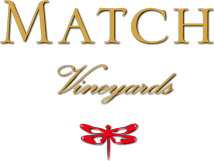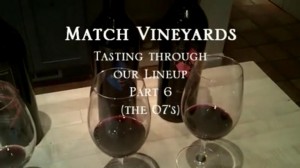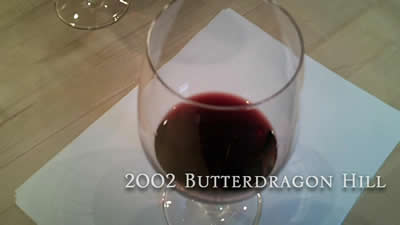A documentary made by Joe Wagner (Caymus), Joel Gott (Joel Gott Wines), and Dave Phinney (Orin Swift) about making a special wine blend to benefit their kids’ school. The documentary is fake.
Our winemaker, Cary Gott, wrote the following article with a generalized description of how one makes various wines. It’s sort of a what to expect from grape to bottle. You can download a PDF copy of this article here.
Wine Production Procedures for White and Red Wines
Cary Gott, Winemaker
Match Vineyards
This describes the winemaking steps for custom crush customers by wine style. Although each winemaker may have some unique techniques, generally this is how various wines are produced, the winemaking steps involved and their common names.
Also I give you some common production numbers we use to quantify production.
The wine styles explained
1. White wine, tank fermented and aged; Sauvignon Blanc & Pinot Grigio
2. White wine, barrel fermented and aged; Chardonnay
3. Rosé
4. Red wine, tank fermented and barrel aged; Cabernet Sauvignon, Zin or Syrah
5. Red wine, tank fermented and tank aged; Cabernet Sauvignon, Zin or Syrah
6. Red wine, barrel fermented and barrel aged; Cabernet Sauvignon, Zin or Syrah
1. White wine, tank fermented and tank aged then bottled
- Grapes are tested and tasted by the winemaker to determine when they are ready to pick
- Winemaker coordinates with winery and vineyard management to determine pick date
- Grapes are delivered to winery in 1/2 ton macro bins and placed out of the sun before processing
- Grapes are loaded into press for whole cluster pressing or destemmed and then pumped to the press
- Grapes are pressed and the juice is pumped to a SS (stainless steel) tank
- Juice is chilled to 50º to 60º F
- Juice is analyzed for the following items
o Brix, the approximate percent sugar, usually brix is 22º to 26º F
o pH
o TA, tartaric acid
o VA, volatile acidity
o YAN, yeast available nitrogen
- Juice is then adjusted for TA and pH if required by adding tartaric acid
- Juice is yeasted and has yeast food added to assist fermentation with DAP and Superfood
- The winemaker may want other fermentation items added to the juice
- In a day or two the juice starts to ferment and temperature is maintained at a constant temperature, usually about 60º F
- It will tank 2 to 3 weeks for the juice to ferment to dryness (dryness is about -1 brix)
- After the wine is dry SO2 is added to the wine based on the wine’s pH
- The winemaker may want to have the lees (yeast sediment on the bottom of the tank) stirred so as to add a mouth-filling soft texture to the wine
- The wine will be racked several times over the period of the next 4 to 6 months. Racking is pumping the wine from the tank to another tank leaving the lees on the bottom of the tank behind. The lees are discarded.
- While the wine is in the tank the free SO2 will be analyzed once a month. If it is too low more SO2 will be added. The amount of SO2 is usually based on the wine’s pH.
- About 45 days before bottling the winemaker & lab determines by analysis the heat and cold stability of the wine.
- If the wine is heat unstable bentonite is added to absorb proteins which could cause a haze in the wine once it is bottled.
- If the wine is cold unstable the wine will be chilled to 28º F for 3 weeks. That will cause tartrate crystals to form on the walls of the tank so they do not form when the wine is in bottle and in the consumer’s refrigerator.
- A few days before bottling the wine will be filtered to another tank and adjusted for sweetness if necessary.
- The wine will then be polish filtered just before bottling as it is being pumped to the bottling line bottle filler
- The bottles will be corked or screw-capped, tin capsules spun on (for cork finished bottles), labeled and put into cases. The cases will be palletized and shipped to the warehouse for aging.
2. White wine, barrel fermented and aged
- The juice production is the same up to the point of juice starting to ferment in the SS tank fermented description above
- Fermenting juice is chilled quite cold (say 50º F) and then pumped into new and used FO (French oak) barrels. Only a small amount of fermentation is complete before it is moved to barrels.
- Each 60 gallon barrel is filed to 50 gallons so there is head room for the fermentation foam that develops during barrel fermentation.
- The fermenting juice now ferments in about 2 weeks to dryness. While it ferments in oak barrels (new and used) it picks up character and style due to the barrels.
- The winemaker will determine if the wine (usually Chardonnay) is to have a malolactic (ML) fermentation. If so, ML bacteria is added to the wine. ML fermentation will take several weeks to complete. Malolactic fermentation is a bacterial fermentation of malic acid in wine.
- Once fermentation is complete the barrels will be topped from other barrels
- Every few weeks the barrels will be stirred with a lees stirrer to mix the lees (yeast cells) into the wine to add body and texture
- The barrels will have monthly free SO2 analysis and topping
- The following spring or summer the wine will be racked from barrels, heat and cold stabilized, filtered and then bottled.
3. Rosé
- Rosé is produced in a method that is similar to SS white wine but first there has to be some color in the juice that is produced from red grapes.
- There are three basic methods for obtaining juice with color:
o Whole clusters of red grapes (Syrah, Pinot Noir) are pressed and the resulting juice is a light rosé color
o Red grapes are crushed and put into the press or a tank to macerate for a few hours. The grapes are then pressed. This produces more color and flavor in the juice.
o Red grapes are crushed to tank and a fermentation is started. Once the fermentation starts the grapes are pressed. This produces a Rosé with substantial color and flavor
- Once the colored juice is obtained the rest of the processing is similar to white juice fermentation in SS
4. Red wine, tank fermented and barrel aged
- Ripe red grapes are destemmed and crushed. The must ( juice with skins and seeds ) is then pumped to a SS tank for fermentation. The tank is jacketed for cooling or heating to maintain proper fermentation temperatures.
- What follows is a typical Napa Valley Cabernet Sauvignon fermentation scenario . . .
- Once the must is in the fermenting tank an analysis of the juice is taken
- 35 ppm SO2 is added to the must
- Fermentation tannins and enzymes might also be added to the must. They help extract flavor and color.
- The must is chilled to a low temperature (50º to 55º) for a 3 to 5 day cold soaking period which allows water in the juice to extract color and flavor from the skins.
- During cold soaking the tank is pumped over two times per day to mix the skins and juice
- Pumping Over is the process of pumping the wine from the bottom valve on the tank to the top of the skins in the tank (the skins float on the juice/wine below). The floating skins are called the Cap.
- At the end of the cold soak period the tank is warmed up to 70º F.
- The tank is yeasted, yeast food is added as well as other red wine fermentation products to assist in the extraction of flavor and color from the skins
- The tank is pumped over 2 or 3 times per day during fermentation.
- Temperature is maintained to 80º to 85º F for proper fermentation.
- When the must is dry (-1 brix) the wine is drained out of the tank and put through a screen to remove seeds and skins and then pumped to another tank. This drained wine is called Freerun (as it ran freely out of the tank)
- The skins and seeds remaining in the tank (Pomace) is shoveled out of the tank and put in bins and then loaded into the press where any wine remaining in the skins is pressed out and put in another tank. That wine is called Press Wine. It may or may not be added back to the Freerun wine.
- ML bacteria will be added to the wine
- The new red wine will stay in the tank for a few days and then be racked to barrels.
- Once in barrels it will complete the ML fermentation in several weeks.
- Once ML complete the barrels will be racked off the lees to a tank where all of the barrels of that lots will be blended. The lees will be discarded.
- SO2 will be added to the new wine
- The wine will then be pumped back to barrel and the aging process of 15 to 20 months begins
- The barrels are topped at least once per month to keep them full, SO2 will be adjusted as necessary
- Every few months the barrels will be racked to tank, barrels cleaned and the pumped back
- When the wine is ready to bottle the wine will be filtered and bottled
5. Red wine, tank fermented and tank aged
- The fermentation technique for this is the same as above but after fermentation the wine stays in SS tanks and is processed with wood chips (to get oak flavors) and micro oxygen (micro ox) which duplicates the very slow oxygen pickup that wines obtains in barrel aging
- once the wine has obtained aging it is blended, filtered and bottled
- This method of aging is substantially less expensive than barrel aging and requires less time to produce bottle ready wines
6. Red wine, barrel fermented and barrel aged
- Currently in the trendy winemaking world this is the ultimate method to produce high-end award winning red wines (especially Cabernet and Syrah)
- New or used barrels have one head (the end of the barrel) removed and the red grape must is put in the barrel to ferment. The barrels are standing.
- Both regular size barrels (60 gallons) and larger puncheons (130+ gallons) are used for the barrel fermentation.
- The fermenting wine is Punched Down by hand to mix the skins with the wine. This is done several time per day.
- Once the fermentation is complete the barrels are dumped into the press and the wine is pumped to tank
- The next steps are the same as red wine fermented in SS tanks
Production numbers
– 1 ton = 160 gallons of wine
– 1 ton = 55 to 65 cases of wine
– 1 ton = 2.8 barrels
– 1 ton of red grapes requires 275 to 300 gallons of tank fermentation capacity for the cap and juice
– 1 barrel = 24 cases of bottled wine
– 1 case = 9 liters or 2.38 gallons
– 1 pallet of bottled cases is usually 56 cases
Part 2 of our video series in which vintner Randy Sloan tastes through our entire lineup of wines. The 2003 Butterdragon Hill Cabernet Sauvignon is featured here.
He’s been called the “Emperor of Wine” not because of the vast viticultural kingdom he rules, but because of the vast influence he holds over the wine industry and the wine buying public. With the stroke of his pen, he can either play king maker and anoint the next big thing in wine or he can doom a brand to failure – or at least to obscurity. That’s a bit of hyperbole, but it is true that the words of Robert M. Parker, Jr. help move the wine world.
I have zero personal experience with Robert Parker. All I knew of him were from reading his books and the Wine Advocate, his monthly newsletter of wine reviews. Second hand, I’d heard that he was pleasant and gracious in person. Professionally, I knew that – at least recently – his company had been tone-deaf in the area of customer service, displaying a George Bush level of blind loyalty to some staff members who, quite frankly, should have been removed from his publication and website. While few readers questioned Mr. Parker’s ethics, a couple of his tasters/staff members stepped in it big-time and to question the questionable invited censure or banning from the then public forum on eRobertParker.com. Since that time, the forum has been made subscription only. With the bannings of dissenters – admittedly perhaps one or two who were rabble-rousers – and the new pay-to-play policy, all is happy in that online kingdom, though quite a bit quieter when it comes to intelligent wine discussion.
Anyway, the purpose of this post is not to skewer Robert Parker. I’ve come not to bury Caesar, but to praise him. I believe he has done more positive for both the wine industry and wine drinkers than any other single person. On November 3, 2010, Mr. Parker sat down in front of about 70 Napa Valley vintners for an informal Question and Answer session. It was my pleasure to attend. These notes are from that session. Unless otherwise indicated, the views here are either direct quotes of Mr. Parker or my interpretation and understanding of what he said.
Mr. Parker started out by giving us some background information. Perhaps his personal history is well-known to some readers, but it wasn’t to me. He comes from a family of dairy farmers in Maryland and in fact, still lives just a few miles from where he grew up. I was surprised to learn that his parents did not drink. His first experience with wine was at a girlfriend’s 16th birthday party. His memory of that Andres Cold Duck wine was throwing up all night afterwards. While in law school, he followed a girlfriend who was studying abroad in France. She had more sophisticated tastes in wine and food than he did at the time and it was through travels with her that he first gained exposure, and later love, of Bordeaux and other French wines and foods. Apparently love was in the air: he is still married to that gal.
The first time he realized that California was a wine region worth investigating was when he purchased a $3.99 bottle of 1970 Parducci Cabernet Sauvignon. He was impressed by its pure and supple fruit.
Mr. Parker stated that he believes that the development of California’s single vineyard wines will be its legacy in the wine world. In fact, he came back to this point throughout the afternoon. While not discounting appellation blends, one could tell that he seems to be most interested in single vineyard wines.
In reference to California vintages, he compared our consistency of quality to chocolate truffles. “Even when you have a bad truffle, it’s good.” He described the 2007 vintage for Napa Cabernet as a “modern day reference point” but said that 2008, while troublesome for many regions and varieties in California, looks “fabulous” for Napa Cabernet. He said that “the sweet spot of 2008 was Napa Cabernet.” [Author’s note: This Q&A Session took place towards the end of Mr. Parker’s tasting trip in California. He had just tried many 2008 Napa Cabs.]
The floor was then opened to questions:
What do you see in Asian markets?
Mr. Parker confirmed what we already knew: that the thirst for fine wine is really growing in Asia and wineries must position themselves to take advantage of that market. He pointed out that the French, in particular, the Bordelais, are ahead of California vintners in marketing and brand recognition in Asia. However, he said that from tastings he has conducted in China, he believes that the Chinese are very open minded about wine. Korea, he pointed out, was a very dynamic wine market with “more wine bars in Seoul than in any other city.” Female wine buyers and sommeliers are also gaining influence. Taiwan and Singapore are good markets but hindered by high taxes on wine imports. Mr. Parker believes that the no tax on wine imports policy of Hong Kong will be a positive influence and perhaps force Korea and Singapore to follow suit.
What about Europe?
Mr. Parker didn’t see much future for Napa wines in Europe saying that they tend to be “too chauvinistic about their own products.” Perhaps some opportunity exists in Russia, but overall he recommended Napa vintners moving internationally should look to Asia and even to South America.
Winemaker Les Behrens asked, “is there any hope for Syrah?”
According to Mr. Parker, Syrah is probably the most satisfying wine at each price point. He pointed to several reasons why Syrah may be having problems. First he said that the flooding of the market by Yellow Tail, industrial style made Shiraz had cheapened the variety. Also, Syrah is made in so many divergent styles that perhaps folks don’t know what they are buying. He suggested that high-end Pinot Noir may be starting “to tank” and that Syrah may move to that position. He referred to the movie Sideways causing too much Pinot Noir to be planted in the wrong places. Wine varieties tend to be victims of their own over popularity as too many wineries try to cash in.
What about Social Media for wineries?
Mr. Parker said that he was one of the first wine writers using the internet, tracing his use back to the old online bulletin board Prodigy and its wine forum. He said that now the internet offers much information about wine ranging in quality from good to bad. Mr. Parker said that a lot of bloggers are just “a lot of white noise” but he does understand why these bloggers’ arrows seem to be aimed at him and Wine Spectator. According to Mr. Parker, it was the same when he started out: he aimed his arrows at the British wine press.
He did not mention Facebook or any of the other social media apps with the exception of Twitter which he says that he started using fairly recently (@RobertMParkerJr). He said that he usually sits down and composes 20-25 tweets at a time and then staggers their release.
His main advice to wineries: have your websites be “interactive” and available in Mandarin, Japanese, and Korean. He also suggested we could pay to have our sites appear higher in Google search results.
[Author’s note: In fairness to Mr. Parker, despite his claim to have been a pioneer in the wine online world, he hasn’t really pushed the envelope to explore much further than those Prodigy days. He’s not really the guy one should ask about wine and social media.]
How do you view your contribution to the prevalent style of Cabernet?
Mr. Parker chuckled and called this topic the “800 lb gorilla in the room.”
He believes that his tastes are often pigeon holed into too narrow an understanding. He then quickly moved off the topic and really didn’t address whether he thought he drove wine styles. He proceeded to describe the “elements of all great wine.”
- If one goes back and reads old diary entries that were written about wines which we recognize today as great, on release, these wines were described as “opulent.”
- Great wine comes from great terroir planted properly with the proper variety.
- Great wine is made from ripe fruit: not under ripe and not over ripe.
- Great wines have to be concentrated in the beginning for them to be concentrated later on.
- Alcohol content is not an issue if the wine is balanced. He said that he never once looked at ABV on a wine. If it tastes hot then it’s an issue.
- Great wine has to have a singular personality
- Great wine fulfills the reason we drink wines: hedonistic enjoyment and intellectual interest. “Do you want a second glass?”
What is your opinion of a classified growth system for California?
Mr. Parker said that he had thought about it, but that it wasn’t his job. He joked that he had enough enemies. He thinks such a system would probably be unnecessary and that ultimately single vineyards and AVAs “will take care of it.”
His advice to Napa, Sonoma, and the Central Coast is to keep telling our story. The greatest threat is complacency. He pointed out what he views as a huge advantage that Napa possesses: our geography sheltering us from weather, pollution, fall out, etc. He said that he thinks about this every time he is in Paulliac (Bordeaux, France) where apparently there is a nuke plant right by the vineyards.
In his opinion, Cabernet and Chardonnay are still king.
Can the image of Merlot come back?
Mr. Parker compared the situation to Pinot Noir: everyone jumps on the craze a lot of bad wine gets made.
What is a good wine pairing for spicy food, specifically Mexican dishes?
No oak, Zinfandel, Rhone Rangers such as Syrah, Grenache, Mourvedre blends, Riesling, Chateauneuf du Pape.
What do you think about Biodynamic farming practices?
Mr. Parker said that his own vineyard has been biodynamic since 2003 [Author’s note: He is part owner in the winery Beaux Freres in Oregon.] He said that he doesn’t think biodynamic farming practices have helped or hurt their wine quality except perhaps this year when biodynamics may have made things tougher because it was a very tough vintage. He said that he believes Biodynamic farming and Organic farming make their difference in marketing because the terms are popular with the public.
What is the demographic of your readership?
They studied this a few years back and he tried to recall from memory
- almost all men
- median age 41 or 42
- a lot of MDs
- high income
- about 55k subscribers
Mr. Parker then brought up recent events on eRobertParker.com that ended up with the online public forum becoming non-public and pay subscription only. He said a similar situation had happened back at Prodigy too. Perhaps “2 dozen troublemakers” “generally single men” “probably still living in the basement of their mother’s house” started making problems. He laughed it off and said that now you can “criticize me, call me whatever you want, but you’re going to have to pay for it.”
Regarding Pierre Rovani, a former Wine Advocate taster, Parker said that he was talented and wonderful, but couldn’t take criticism.
[Author’s note: It wasn’t clear why Mr. Parker made the last statement. It is especially ironic because my observations of the event described by Mr. Parker as the actions of a couple of dozen troublemakers was actually an example that Rovani is not the only wine critic who could not take criticism. There are two sides to this story.]
And finally, someone asked if there is an heir apparent to Robert Parker.
His answer: Antonio Galloni
Overall, I was impressed by Mr. Parker’s thoughtfulness, his candor, and his understanding of the wine industry. Whether the emporer lives in an ivory tower, unable to see what some of his underlings are doing to his image, or whether he just doesn’t care what those of us he rules think, I’ll leave that to another writer to decide. On this afternoon, in front of the Napa Vintners, he was gracious, sincere, and well-spoken. He possessed a humble demeanor and a frank style that I enjoyed very much.




